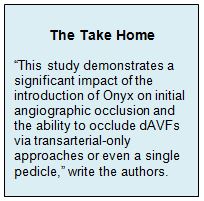Key Points:
- Study examines compares endovascular treatment of dAVFs before vs after introduction of Onyx
- Number of dAVFs treated endovascularly has doubled, outcomes have improved

For the study, Felipe C. Albuquerque, MD, of St. Joseph’s Hospital and Medical Center (Phoenix, AZ), and colleagues identified 251 patients with 260 distinct dAVFs from their database who were treated initially endovascularly between January 1996 and September 2015.
The initial angiographic occlusion rate was 70%. Subsequent angiography revealed a recurrence or occult residual lesion in 3% of cases. The overall complication rate was 8%, with permanent neurological complications occurring in 3% of cases.
Of the 260 dAVFs, 102 were Type I, 72 were Type II, and 86 were Type III/IV. Among the 102 Type I lesions, the rate of resolution or improvement was 79% for pulsatile tinnitus and 78% for ocular symptoms.
From 1996 to 2006, prior to the introduction of Onyx (Covidien), 87 dAVFs were treated at the center. Twice as many dAVFs were treated in the following decade, after Onyx was available. Comparing these two periods revealed significant improvements in rates of initial angiographic occlusion dAVFs obliterated via a transarterial-only approach or via a single arterial pedicle (table 1).
“This study demonstrates a significant impact of the introduction of Onyx on initial angiographic occlusion and the ability to occlude dAVFs via transarterial-only approaches or even a single pedicle,” write the authors.
Hard Numbers Useful for Patient Counseling
Despite the study’s limitations as a retrospective analysis from a single center without independent outcome adjudication, the authors report that these findings of “an overall rate of approximately 80% for initial angiographic occlusion in the Onyx era, and an approximately 80% rate of meaningful clinical improvement in tinnitus and/or ocular symptoms after treatment” can be used to counsel patients who are considering an endovascular intervention.
“Initial angiographic results should be evaluated with careful scrutiny for effective casting of the draining vein, and delayed follow-up complete angiography must be performed to confirm a true durable angiographic ‘cure’ for high-risk lesions,” recommend the authors. “With more stringent criteria for the declaration of initial angiographic occlusion and subsequent angiographic cure, recurrence after dAVF treatment is rare.”
Source:
- Gross BA, Albuquerque FC, Moon K, et al. Evolution of treatment and a detailed analysis of occlusion, recurrence, and clinical outcomes in an endovascular library of 260 dural arteriovenous fistulas. J Neurosurg. 2016;Epub ahead of print.
Disclosures:
- Dr. Albuquerque reports no relevant conflicts of interest


